Xiang An
RealSyn: An Effective and Scalable Multimodal Interleaved Document Transformation Paradigm
Feb 18, 2025Abstract:After pre-training on extensive image-text pairs, Contrastive Language-Image Pre-training (CLIP) demonstrates promising performance on a wide variety of benchmarks. However, a substantial volume of non-paired data, such as multimodal interleaved documents, remains underutilized for vision-language representation learning. To fully leverage these unpaired documents, we initially establish a Real-World Data Extraction pipeline to extract high-quality images and texts. Then we design a hierarchical retrieval method to efficiently associate each image with multiple semantically relevant realistic texts. To further enhance fine-grained visual information, we propose an image semantic augmented generation module for synthetic text production. Furthermore, we employ a semantic balance sampling strategy to improve dataset diversity, enabling better learning of long-tail concepts. Based on these innovations, we construct RealSyn, a dataset combining realistic and synthetic texts, available in three scales: 15M, 30M, and 100M. Extensive experiments demonstrate that RealSyn effectively advances vision-language representation learning and exhibits strong scalability. Models pre-trained on RealSyn achieve state-of-the-art performance on multiple downstream tasks. To facilitate future research, the RealSyn dataset and pre-trained model weights are released at https://github.com/deepglint/RealSyn.
ORID: Organ-Regional Information Driven Framework for Radiology Report Generation
Nov 20, 2024Abstract:The objective of Radiology Report Generation (RRG) is to automatically generate coherent textual analyses of diseases based on radiological images, thereby alleviating the workload of radiologists. Current AI-based methods for RRG primarily focus on modifications to the encoder-decoder model architecture. To advance these approaches, this paper introduces an Organ-Regional Information Driven (ORID) framework which can effectively integrate multi-modal information and reduce the influence of noise from unrelated organs. Specifically, based on the LLaVA-Med, we first construct an RRG-related instruction dataset to improve organ-regional diagnosis description ability and get the LLaVA-Med-RRG. After that, we propose an organ-based cross-modal fusion module to effectively combine the information from the organ-regional diagnosis description and radiology image. To further reduce the influence of noise from unrelated organs on the radiology report generation, we introduce an organ importance coefficient analysis module, which leverages Graph Neural Network (GNN) to examine the interconnections of the cross-modal information of each organ region. Extensive experiments an1d comparisons with state-of-the-art methods across various evaluation metrics demonstrate the superior performance of our proposed method.
Croc: Pretraining Large Multimodal Models with Cross-Modal Comprehension
Oct 18, 2024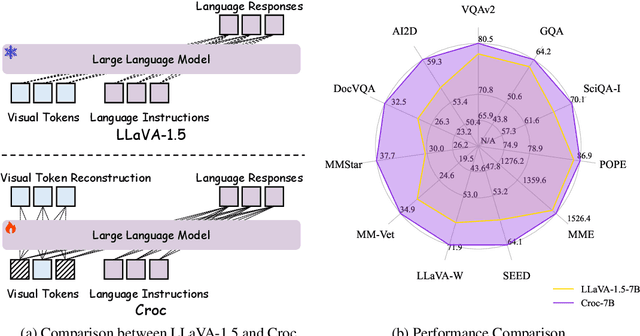
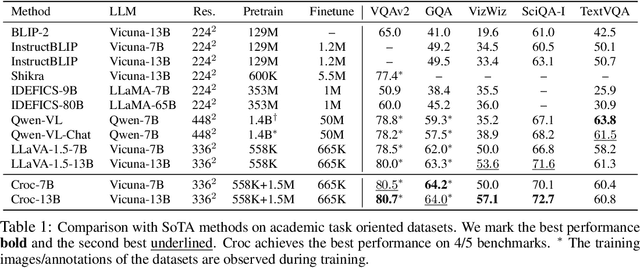
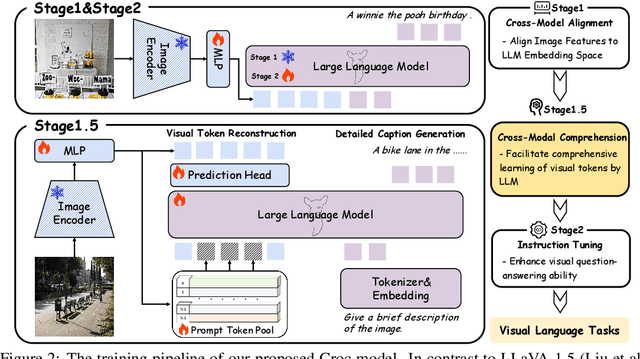

Abstract:Recent advances in Large Language Models (LLMs) have catalyzed the development of Large Multimodal Models (LMMs). However, existing research primarily focuses on tuning language and image instructions, ignoring the critical pretraining phase where models learn to process textual and visual modalities jointly. In this paper, we propose a new pretraining paradigm for LMMs to enhance the visual comprehension capabilities of LLMs by introducing a novel cross-modal comprehension stage. Specifically, we design a dynamically learnable prompt token pool and employ the Hungarian algorithm to replace part of the original visual tokens with the most relevant prompt tokens. Then, we conceptualize visual tokens as analogous to a "foreign language" for the LLMs and propose a mixed attention mechanism with bidirectional visual attention and unidirectional textual attention to comprehensively enhance the understanding of visual tokens. Meanwhile, we integrate a detailed caption generation task, leveraging rich descriptions to further facilitate LLMs in understanding visual semantic information. After pretraining on 1.5 million publicly accessible data, we present a new foundation model called Croc. Experimental results demonstrate that Croc achieves new state-of-the-art performance on massive vision-language benchmarks. To support reproducibility and facilitate further research, we release the training code and pre-trained model weights at https://github.com/deepglint/Croc.
CLIP-CID: Efficient CLIP Distillation via Cluster-Instance Discrimination
Aug 18, 2024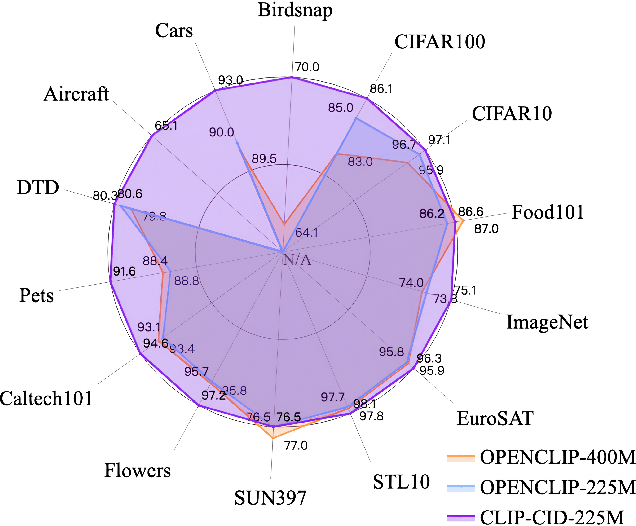
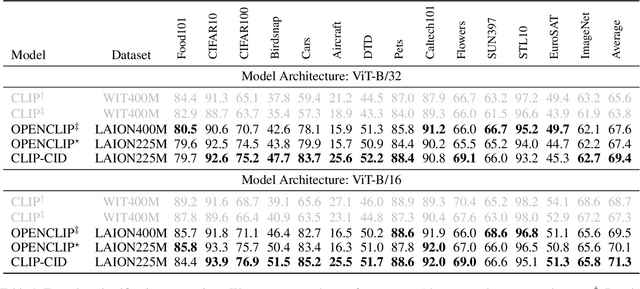
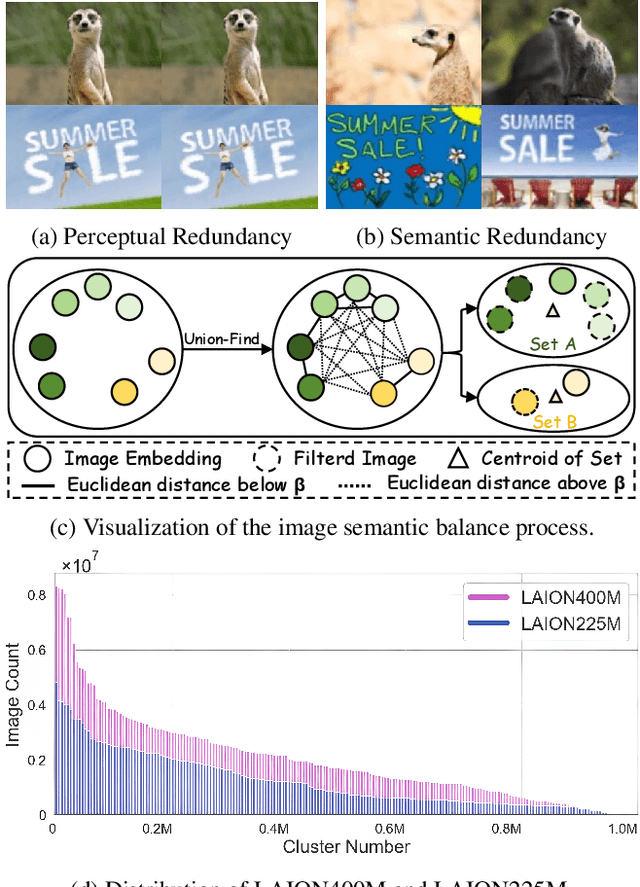
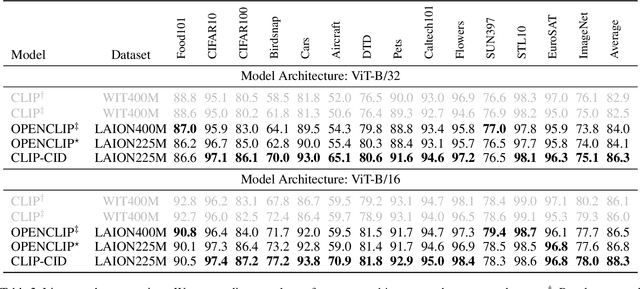
Abstract:Contrastive Language-Image Pre-training (CLIP) has achieved excellent performance over a wide range of tasks. However, the effectiveness of CLIP heavily relies on a substantial corpus of pre-training data, resulting in notable consumption of computational resources. Although knowledge distillation has been widely applied in single modality models, how to efficiently expand knowledge distillation to vision-language foundation models with extensive data remains relatively unexplored. In this paper, we introduce CLIP-CID, a novel distillation mechanism that effectively transfers knowledge from a large vision-language foundation model to a smaller model. We initially propose a simple but efficient image semantic balance method to reduce transfer learning bias and improve distillation efficiency. This method filters out 43.7% of image-text pairs from the LAION400M while maintaining superior performance. After that, we leverage cluster-instance discrimination to facilitate knowledge transfer from the teacher model to the student model, thereby empowering the student model to acquire a holistic semantic comprehension of the pre-training data. Experimental results demonstrate that CLIP-CID achieves state-of-the-art performance on various downstream tasks including linear probe and zero-shot classification.
VAR-CLIP: Text-to-Image Generator with Visual Auto-Regressive Modeling
Aug 02, 2024Abstract:VAR is a new generation paradigm that employs 'next-scale prediction' as opposed to 'next-token prediction'. This innovative transformation enables auto-regressive (AR) transformers to rapidly learn visual distributions and achieve robust generalization. However, the original VAR model is constrained to class-conditioned synthesis, relying solely on textual captions for guidance. In this paper, we introduce VAR-CLIP, a novel text-to-image model that integrates Visual Auto-Regressive techniques with the capabilities of CLIP. The VAR-CLIP framework encodes captions into text embeddings, which are then utilized as textual conditions for image generation. To facilitate training on extensive datasets, such as ImageNet, we have constructed a substantial image-text dataset leveraging BLIP2. Furthermore, we delve into the significance of word positioning within CLIP for the purpose of caption guidance. Extensive experiments confirm VAR-CLIP's proficiency in generating fantasy images with high fidelity, textual congruence, and aesthetic excellence. Our project page are https://github.com/daixiangzi/VAR-CLIP
Multi-label Cluster Discrimination for Visual Representation Learning
Jul 24, 2024



Abstract:Contrastive Language Image Pre-training (CLIP) has recently demonstrated success across various tasks due to superior feature representation empowered by image-text contrastive learning. However, the instance discrimination method used by CLIP can hardly encode the semantic structure of training data. To handle this limitation, cluster discrimination has been proposed through iterative cluster assignment and classification. Nevertheless, most cluster discrimination approaches only define a single pseudo-label for each image, neglecting multi-label signals in the image. In this paper, we propose a novel Multi-Label Cluster Discrimination method named MLCD to enhance representation learning. In the clustering step, we first cluster the large-scale LAION-400M dataset into one million centers based on off-the-shelf embedding features. Considering that natural images frequently contain multiple visual objects or attributes, we select the multiple closest centers as auxiliary class labels. In the discrimination step, we design a novel multi-label classification loss, which elegantly separates losses from positive classes and negative classes, and alleviates ambiguity on decision boundary. We validate the proposed multi-label cluster discrimination method with experiments on different scales of models and pre-training datasets. Experimental results show that our method achieves state-of-the-art performance on multiple downstream tasks including linear probe, zero-shot classification, and image-text retrieval.
High-Fidelity Facial Albedo Estimation via Texture Quantization
Jun 19, 2024



Abstract:Recent 3D face reconstruction methods have made significant progress in shape estimation, but high-fidelity facial albedo reconstruction remains challenging. Existing methods depend on expensive light-stage captured data to learn facial albedo maps. However, a lack of diversity in subjects limits their ability to recover high-fidelity results. In this paper, we present a novel facial albedo reconstruction model, HiFiAlbedo, which recovers the albedo map directly from a single image without the need for captured albedo data. Our key insight is that the albedo map is the illumination invariant texture map, which enables us to use inexpensive texture data to derive an albedo estimation by eliminating illumination. To achieve this, we first collect large-scale ultra-high-resolution facial images and train a high-fidelity facial texture codebook. By using the FFHQ dataset and limited UV textures, we then fine-tune the encoder for texture reconstruction from the input image with adversarial supervision in both image and UV space. Finally, we train a cross-attention module and utilize group identity loss to learn the adaptation from facial texture to the albedo domain. Extensive experimentation has demonstrated that our method exhibits excellent generalizability and is capable of achieving high-fidelity results for in-the-wild facial albedo recovery. Our code, pre-trained weights, and training data will be made publicly available at https://hifialbedo.github.io/.
RWKV-CLIP: A Robust Vision-Language Representation Learner
Jun 11, 2024Abstract:Contrastive Language-Image Pre-training (CLIP) has significantly improved performance in various vision-language tasks by expanding the dataset with image-text pairs obtained from websites. This paper further explores CLIP from the perspectives of data and model architecture. To address the prevalence of noisy data and enhance the quality of large-scale image-text data crawled from the internet, we introduce a diverse description generation framework that can leverage Large Language Models (LLMs) to synthesize and refine content from web-based texts, synthetic captions, and detection tags. Furthermore, we propose RWKV-CLIP, the first RWKV-driven vision-language representation learning model that combines the effective parallel training of transformers with the efficient inference of RNNs. Comprehensive experiments across various model scales and pre-training datasets demonstrate that RWKV-CLIP is a robust and efficient vision-language representation learner, it achieves state-of-the-art performance in several downstream tasks, including linear probe, zero-shot classification, and zero-shot image-text retrieval. To facilitate future research, the code and pre-trained models are released at https://github.com/deepglint/RWKV-CLIP
Plug-and-Play Grounding of Reasoning in Multimodal Large Language Models
Mar 28, 2024Abstract:The surge of Multimodal Large Language Models (MLLMs), given their prominent emergent capabilities in instruction following and reasoning, has greatly advanced the field of visual reasoning. However, constrained by their non-lossless image tokenization, most MLLMs fall short of comprehensively capturing details of text and objects, especially in high-resolution images. To address this, we propose P2G, a novel framework for plug-and-play grounding of reasoning in MLLMs. Specifically, P2G exploits the tool-usage potential of MLLMs to employ expert agents to achieve on-the-fly grounding to critical visual and textual objects of image, thus achieving deliberate reasoning via multimodal prompting. We further create P2GB, a benchmark aimed at assessing MLLMs' ability to understand inter-object relationships and text in challenging high-resolution images. Comprehensive experiments on visual reasoning tasks demonstrate the superiority of P2G. Noteworthy, P2G achieved comparable performance with GPT-4V on P2GB, with a 7B backbone. Our work highlights the potential of plug-and-play grounding of reasoning and opens up a promising alternative beyond model scaling.
IDAdapter: Learning Mixed Features for Tuning-Free Personalization of Text-to-Image Models
Mar 21, 2024Abstract:Leveraging Stable Diffusion for the generation of personalized portraits has emerged as a powerful and noteworthy tool, enabling users to create high-fidelity, custom character avatars based on their specific prompts. However, existing personalization methods face challenges, including test-time fine-tuning, the requirement of multiple input images, low preservation of identity, and limited diversity in generated outcomes. To overcome these challenges, we introduce IDAdapter, a tuning-free approach that enhances the diversity and identity preservation in personalized image generation from a single face image. IDAdapter integrates a personalized concept into the generation process through a combination of textual and visual injections and a face identity loss. During the training phase, we incorporate mixed features from multiple reference images of a specific identity to enrich identity-related content details, guiding the model to generate images with more diverse styles, expressions, and angles compared to previous works. Extensive evaluations demonstrate the effectiveness of our method, achieving both diversity and identity fidelity in generated images.
 Add to Chrome
Add to Chrome Add to Firefox
Add to Firefox Add to Edge
Add to Edge